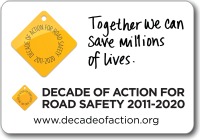The World Day of Remembrance for Road Traffic Victims(link is external)
The World Day of Remembrance for Road Traffic Victims (WDR) is commemorated on the third Sunday of November each year – to remember the many millions killed and injured on the world’s roads, together with their families and many others also affected, as well as reflect on the tremendous burden and cost of this daily continuing disaster. This day, initiated by road victims in 1993 and adopted by the UN on 26th October 2005, is dedicated to remembering the many millions killed and injured in road crashes, their families and communities.


